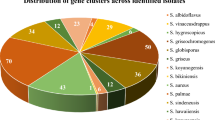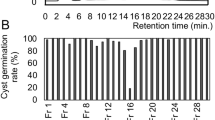Abstract
Magnaporthe oryzae is the causal agent of blast disease of cereals such as rice. Recently, fungal isolates resistant to the melanin biosynthesis inhibitors-dehydratase (MBI-D), which inhibits scytalone dehydratase (SH), have been detected in Japan. The isolates have a single point mutation in the gene encoding SH. In fitness tests, resistant isolates showed reduced fitness, compared with that of sensitive isolates. To investigate the factors contributing to the reduced fitness of resistant isolates, we compared the enzyme activities of SHs purified from sensitive and resistant isolates. Enzyme kinetics analyses revealed that the SHs from MBI-D-sensitive and MBI-D-resistant isolates had Michaelis constant values of 53.2 ± 14.6 and 44.3 ± 9.9 μmol, respectively, maximal velocity values of 20.0 ± 2.1 and 10.2 ± 0.9 μmol min−1, respectively, and catalytic constant values of 38.2 ± 4.1 and 19.6 ± 1.7 s−1, respectively. Thus, the activity of MBI-D-sensitive-type SHs was approximately double that of MBI-D-resistant-type SHs. The sensitive-type SHs had higher scytalone dehydration activity than that of resistant-type SHs at temperatures ranging from 15 to 35 °C and at pHs ranging from 6.0 to 9.0. Thus, the sensitive-type SH showed higher scytalone dehydration activity than that of the resistant-type SH under the natural environmental conditions of M. oryzae. In infection tests, the MBI-D-sensitive isolates infected rice leaves faster than did the resistant isolates. Thus, the acquisition of resistance to MBI-D has negatively affected the pathogenicity of M. oryzae due to decreased SH activity. These results have implications for disease management programs.




Similar content being viewed by others
References
Chida, T., & Sisler, H. D. (1987). Restoration of appressorial penetration ability by melanin precursor in Pyricularia oryzae treated with antipenetrants and in melanin-deficient mutants. Journal of Pesticide Science, 12, 49–55.
Hirooka, T., Uchigurohane, T., & Nishiguchi, T. (1999). Monitoring sensitivity of field isolates of Pyricularia oryzae to isoprothiolane, IBP and EDDP from 1993-96. Japanese Journal of Phytopathology, 65, 61–66.
Howard, J. R., & Ferrari, A. M. (1989). Role of melanin in appressorium function. Experimental Mycology, 13, 403–418.
Inoue, S., Maeda, K., Uematsu, T., & Kato, T. (1984). Comparison of tetrachlorophthalide and pentachlorobenzyl alcohol with chlobenthiazone and other melanin inhibitors in the mechanism of rice blast control. Journal of Pesticide Science, 9, 731–736.
Ito, I., & Yamaguchi, T. (1977). Occurrence of kasugamycin-resistant rice blast fungus influenced by the application of fungicides. Japanese Journal of Phytopathology, 43, 301–303.
Ito, I., & Yamaguchi, T. (1979). Competition between sensitive and resistant strains of Pyricularia oryzae Cav. against kasugamycin. Japanese Journal of Phytopathology, 45, 40–46.
Katagiri, M., Uesugi, Y., & Umehara, Y. (1980). Development of resistance to organophosphorus fungicides in Pyricularia oryzae in the field. Journal of Pesticide Science, 5, 417–421.
Kimura, N., & Fujimoto, H. (2015). Fitness studies between field isolates of Magnaporthe oryzae resistant and sensitive to scytalone dehydratase inhibitors of melanin biosynthesis (MBI-Ds) and decline of frequency of resistant isolates at a rice field. Journal of Plant Diseases and Protection, 122, 224–228.
Kubo, Y., Suzuki, K., Furusawa, I., & Yamamoto, M. (1983). Scytalone as a natural intermediate of melanin biosynthesis in appressoria of Colletotrichum lagenarium. Experimental Mycology, 7, 208–215.
Kurahashi, Y., Araki, Y., Kinbara, T., Pontzen, R., & Yamaguchi, I. (1998). Intermediates accumulation and inhibition sites of carpropamid in the melanin biosynthesis pathway of Pyricularia oryzae. Journal of Pesticide Science, 23, 22–28.
Kurahashi, Y., Hattori, T., Kagabu, S., & Pontzen, R. (1996). Mode of action of the novel rice blast fungicide KTU 3616. Pesticide Science, 47, 199–202.
Kurahashi, Y., Sakawa, S., Kinbara, T., Tanaka, K., & Kagabu, S. (1997). Biological activity of carpropamid (KTU 3616): A new fungicide for rice blast disease. Journal of Pesticide Science, 22, 108–112.
Lundqvist, T., Weber, C. P., Braswell, H. E., Rice, J., & Pierce, J. (1993). Preliminary crystallographic studies on scytalone dehydratase from Magnaporthe grisea. Journal of Molecular Biology, 232, 999–1002.
Miyagi, Y., Hirooka, T., & Araki, F. (1986). Relative parastic fitness of isolates of Pyricularia oryzae Cav. with different sensitivities to fungicides. Pesticide Science, 17, 653–658.
Motoyama, T., Imanishi, K., Kinbara, T., Kurahashi, Y., & Yamaguchi, I. (1998). Inhibition of scytalone dehydratase in melanin biosynthesis by carpropamid, a novel rice blast controlling agent. Journal of Pesticide Science, 23, 58–61.
Nakasako, M., Motoyama, T., Kurahashi, Y., & Yamaguchi, I. (1998). Cryogenic X-ray crystal structure analysis for the complex of scytalone dehydratase of a rice blast fungus and its tight-binding inhibitor, carpropamid: Structural basis of tight-binding inhibition. Biochemistry, 37, 9931–9939.
Sawada, H., Sugihara, M., Takagaki, M., & Nagayama, K. (2004). Monitoring and characterization of Magnaporthe grisea isolates with decreased sensitivity to scytalone dehydratase inhibitors. Pest Management Science, 60, 777–785.
Suzuki, F., Yamaguchi, J., Koba, A., Nakajima, T., & Arai, M. (2010). Changes in fungicide resistance frequency and population structure of Pyricularia oryzae after discontinuance of MBI-D fungicides. Plant Disease, 94, 329–334.
Takagaki, M., Kaku, K., Watanabe, S., Kawai, K., Shimizu, T., Sawada, H., et al. (2004). Mechanism of resistance to carpropamid in Magnaporthe grisea. Pest Management Science, 60, 921–926.
Tsuji, G., Takeda, T., Furusawa, I., Horino, O., & Kubo, Y. (1997). Carpropamid, an anti-rice blast fungicide, inhibits scytalone dehydratase activity and appressorial penetration in Colletotrichum lagenarium. Pesticide Biochemistry and Physiology, 57, 211–219.
Vogel, H. J. (1956). A convenient growth medium for Neurospora (Medium N). Microbial Genetics Bulletin, 13, 42–43.
Wawrzak, Z., Sandalova, T., Steffens, J. J., Basarab, G. S., Lundqvist, Y., & Jordan, D. B. (1999). High-resolution structures of scytalone dehydratase-inhibitor complexes crystallized at physiological pH. Proteins: Structure, Function, and Bioinformatics, 35, 425–439.
Yamada, N., Motoyama, T., Nakasako, M., Kagabu, S., Kudo, T., & Yamaguchi, I. (2004). Enzymatic characterization of scytalone dehydratase Val75Met variant found in melanin biosynthesis dehydratase inhibitor (MBI-D) resistant strains of the rice blast fungus. Bioscience, Biotechnology, and Biochemistry, 68, 615–621.
Funding
This research received no specific grant from any funding agency in the public, commercial, or not-for-profit sectors.
Author information
Authors and Affiliations
Corresponding author
Ethics declarations
Conflict of interest
The authors declare that they have no conflict of interest.
Rights and permissions
About this article
Cite this article
Kimura, N., Fujimoto, H. Comparison of scytalone dehydratase activities between scytalone dehydratase inhibitor-sensitive and inhibitor-resistant Magnaporthe oryzae isolates. J Plant Dis Prot 124, 525–532 (2017). https://doi.org/10.1007/s41348-017-0104-x
Received:
Accepted:
Published:
Issue Date:
DOI: https://doi.org/10.1007/s41348-017-0104-x




